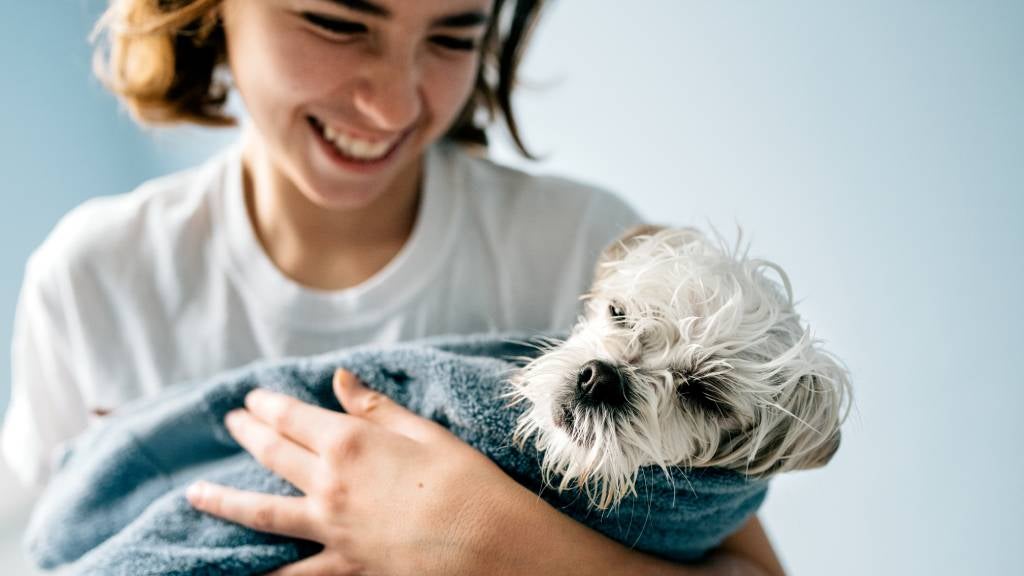7 tips before grooming your pet at home

Regular grooming at home gives you a chance to really get to know what’s ‘normal’ for your pets, it’s just like doing a regular breast exam or mole check on yourself. Getting hands on means it’s more likely you’ll pick up changes like matts, lumps, wounds, and parasites. Grooming also provides a great opportunity for you and your pet to bond. Help them to look good, feel good and stay well, ka pai!
Here are some pointers on how to make home grooming a success:
Start young and make it fun
Building a grooming routine into puppy and kitten training sets you both up for success. Begin by getting them used to being handled and reward good behaviour with treats or toys. Wet food or pet-safe peanut butter can be smeared on lick mats for a hands-free way to distract puppies and kittens and create positive associations with grooming. The face and feet are key areas that many pets feel uncomfortable about, so normalise it early.
Create a calm and relaxed atmosphere
Imagine getting a haircut while your hairdresser is distracted by Snapchat, Instagram, kids yelling, or trying to clean the salon at the same time – not good! The less distractions the better their experience will be. Just like us, a high-stress environment doesn’t tend to lend itself to relaxation. If you get frustrated, it’ll only make it worse next time!
Book a regular time, but keep it short
Keep sessions short initially and start by doing one thing at a time. It makes it easier for you to find the time and for your pet to stay focused. Depending on your pets’ requirements, grooming may be needed daily for thick coats prone to matting; to monthly for low maintenance pets.
Get professional help to get you started
Talk to your local veterinarian or a professional pet groomer about what your pet is likely to require. They can demonstrate how to clip nails, check teeth, check ears and explain any health issues you should be aware of. They can also advise on the best brush and/or shampoo for your pet’s coat type or clippers if they’re required.
Use the right tools
You don’t need cutting edge grooming tools, but human tools don’t work so well on most pet fur. Talk to the professionals about what you’ll need, especially if your pet has a pre-existing skin condition. Test any shampoos, lotions or powders on a small patch of skin first and stay away from heavily scented products.
Take note of the seasons
Wet and cold conditions increase the risk of dirt, but also increase the risk of hypothermia, especially when wet or for those with short coats. Hot summer weather increases the risk of parasites, allergies, sunburn and skin infections, especially if the coat gets matted. Take care all year round with bathing, if required, making sure any shampoo is completely rinsed away and the coat is thoroughly dried to prevent skin infections from developing.
Know your limits
Stop if your pet becomes distressed and try to work out why before you try again. Unless advised by your veterinarian, plucking ears and squeezing anal glands is not something you need to include in your regular grooming plan. While toothbrushing is an excellent way to help prevent tooth disease if your pet will tolerate it, don’t try to remove tartar or discolouration from teeth. This needs to be done by a veterinarian under anaesthetic.
Severely matted coats may also require sedation to remove without causing pain. Of course, if you notice anything unusual or it seems to be painful for your pet, seek help from your veterinarian.
You can also look at the option of working with a reputable trainer to help make grooming a positive experience for both you and your pet especially if they seem uneasy.
Grooming your pet at home can be as simple or complicated as you want to make it, but it will help you get to know your pet better from nose to tail. Knowing what’s ‘normal’ helps you detect changes early and gives you the chance to take action while the problem is small. And while you’re working at giving them the good life, consider taking out SPCA Pet Insurance to help take the financial worry out of providing care for your pet.
22 Nov 2021